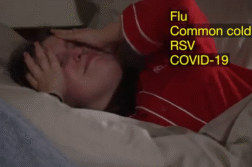ORLANDO, Fla. (Ivanhoe Newswire) — It’s springtime and that means one thing—it’s the start of baseball season. Almost half a million kids take to the playing field in high school. But did you know that almost 50 percent of all pitchers get injured at some point? They’re hardest hit with shoulder and elbow injuries. But now, some doctors are calling for a re-write of the rule book, in hopes of keeping more student athletes’ injury-free from pitching injuries.
Before they can get here …
They start here. By age 14, pitches can reach 80 miles per hour! But it can take its toll on growing arms and elbows.
“These overuse injuries, particularly at our adolescent level, are continuing to grow.” says Jason Zaremski, MD, Sports Medicine Specialist at the University of Florida.
Doctor Zaremski is the director of the University of Florida Health Throwing clinic. He’s seen an uptick in torn UCL’s.
Doctor Zaremski says, “We call it a Little League elbow. The fancy term is called apophysis or inflammation at the growth plate in the elbow.”
In a paper published in the Clinical Journal of Sport Medicine, Doctor Zaremski calls for stricter guidelines—starting with enforced pitch counts.
“These guidelines that are out there are primarily at the high school level, but when you go play in travel ball leagues and summer leagues, those regulations don’t necessarily have to be followed.” explains Doctor Zaremski.
Players 14 and younger who throw 25 or more pitches should not pitch the following day.
Doctor Zaremski says, “If you include warmup and your bullpen and throwing between innings, you’re actually throwing about 40% more pitches.”
No pitching off the mound in practice on consecutive days. And teens should stop using weighted baseballs in practice.
“You’re throwing more and throwing harder. At some point your elbow’s going to break down.” says Doctor Zaremski.
And although these injuries are not life-threatening … they can sideline players for a year. Pitching injuries.
Doctor Zaremski is also suggesting that schools formalize a four-week ramp-up period before the baseball season begins to allow players’ arms to strengthen. By the way, the proposed guidelines do not pertain to softball players as their pitch is different and doesn’t cause the same type of stress to the player’s arms. Another sport where players are at risk—throwing the javelin. In fact, according to the Wall Street Journal, Los Angeles Dodgers pitcher, Yoshinobu Yamamoto started hurling a javelin to warm up his whole body before the baseball game. He says the mechanics of tossing a javelin helps him pitch with his full body, protecting the health of his elbow.
Contributors to this news report include: Marsha Lewis, Producer; Roque Correa, Editor. Matt Goldschmidt, Videographer
Sources:
https://ryortho.com/breaking/50-of-high-school-baseball-pitchers-are-injured-why/
PREVENTING PITCHING INJURIES: REWRITING THE HIGH SCHOOL RULEBOOK
REPORT #3169
BACKGROUND: In the United States, youth sports injuries are a rising concern. According to various sources, nearly 45% of all sports-related injuries in children are from playing baseball or basketball. Pitching injuries. In fact, girls may be up to eight times more likely than boys to tear their anterior cruciate ligament when playing certain types of sports. More than 3.5 million children in the U.S. ages 14 and under receive medical treatment for sports injuries each year. An estimated 30 million children and adolescents each year play in organized sports leading to 3 million annual sports-related injuries. Approximately 2.2 million U.S. children each year suffer injury due to these activities with 62% of youth sporting injuries occurring during practice sessions. And roughly one third of young athletes will experience a dental injury while playing competitively, which should be a good reminder to always wear protective gear.
(Source: https://gitnux.org/youth-sports-injury-statistics/ )
BASEBALL SHOULDER AND ELBOW INJURIES: Tears or ruptures of the ulnar collateral ligament (UCL) are the most common elbow injuries among youth and professional players, especially pitchers. Almost 57% of UCL reconstruction surgeries in the U.S. involve 15-19-year-olds. A study found that about 27% of 845 elite high school pitchers who threw for pro baseball scouts in showcase events went on to have reconstructive UCL surgery. The surgery involves rebuilding the ligament by transplanting a tendon, usually from the patient’s wrist. Recovery lasts up to a year, and about 90% of patients can return to their previous level of performance. The repetitive motion of pitching can cause damage to the UCL, which connects the upper arm bone to the larger of the two forearm bones.
TREATMENT: Most elbow pain caused by throwing can be treated with rest, which allows the elbow to recover from inflammation and injury. Doctors might also recommend conservative treatment options such as applying ice to help reduce swelling and taking nonsteroidal anti-inflammatory drugs. In more severe cases, additional treatment options may be necessary to aid the recovery process and get the athlete back to competition. These options may include physical therapy, throwing analysis, and, in rare cases, surgery.
“The best treatment of pitcher’s elbow is prevention. Maintaining flexibility and strength, throughout the kinetic chain, are key to avoiding overuse injury. Using proper throwing mechanics, adhering to pitch counts and avoiding off-speed pitches at a young age can help to prevent permanent injury in throwers with immature elbows. If you have experienced sudden or recurrent elbow pain, it’s important to rest the elbow immediately and seek medical attention if the pain does not rapidly improve or if it returns after a short bout of rest.” says Dr. Gramstad a Rebound orthopedic surgeon with fellowship training in shoulder and elbow surgery.
(Source: https://www.reboundmd.com/news/pitcher-s-elbow-symptoms-treatments )
* For More Information, Contact:
Matt Walker, Media Relations
University of Florida Health
352-265-8395
Free weekly e-mail on Medical Breakthroughs from Ivanhoe. To sign up: http://www.ivanhoe.com/ftk



